National Kitchen by Violet Oon – Authentically Singapore Flavours at National Gallery
December 15, 2015

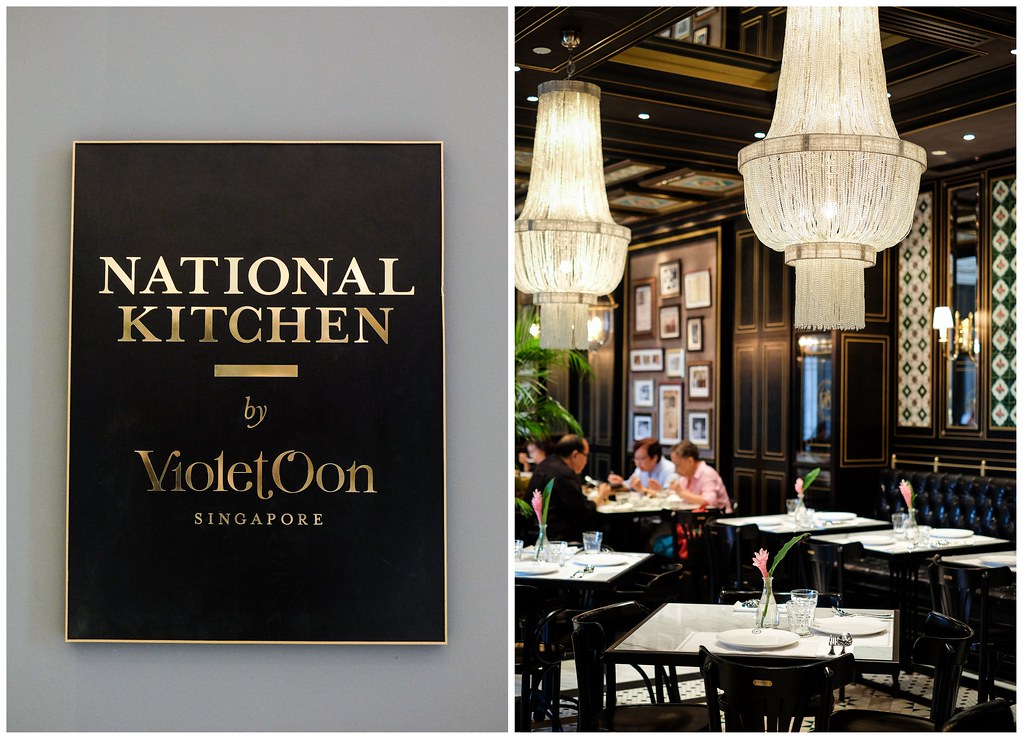
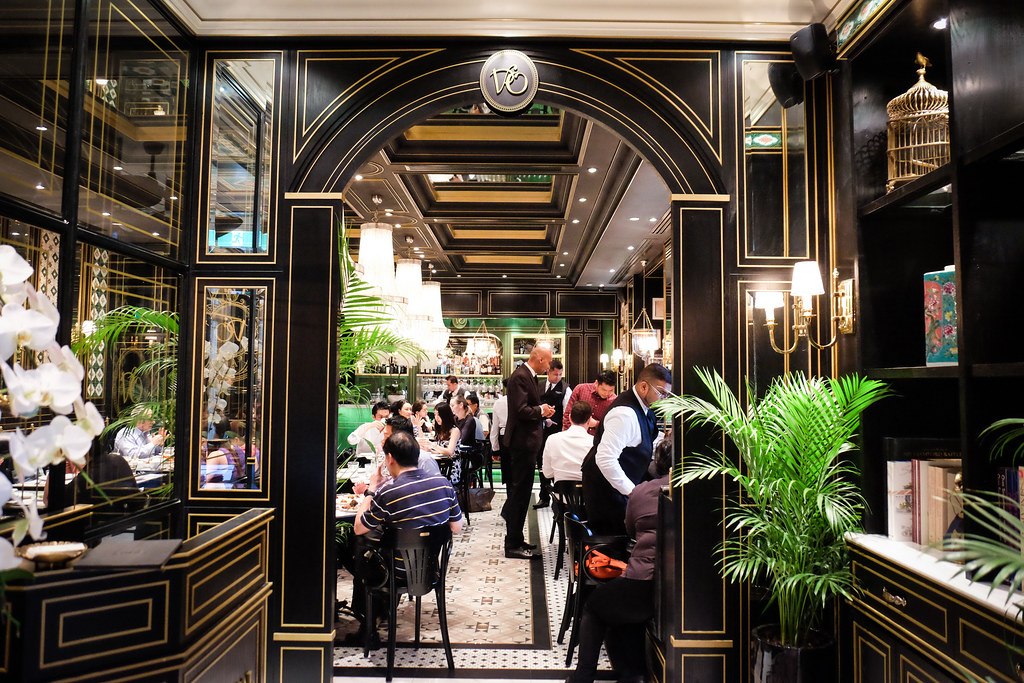
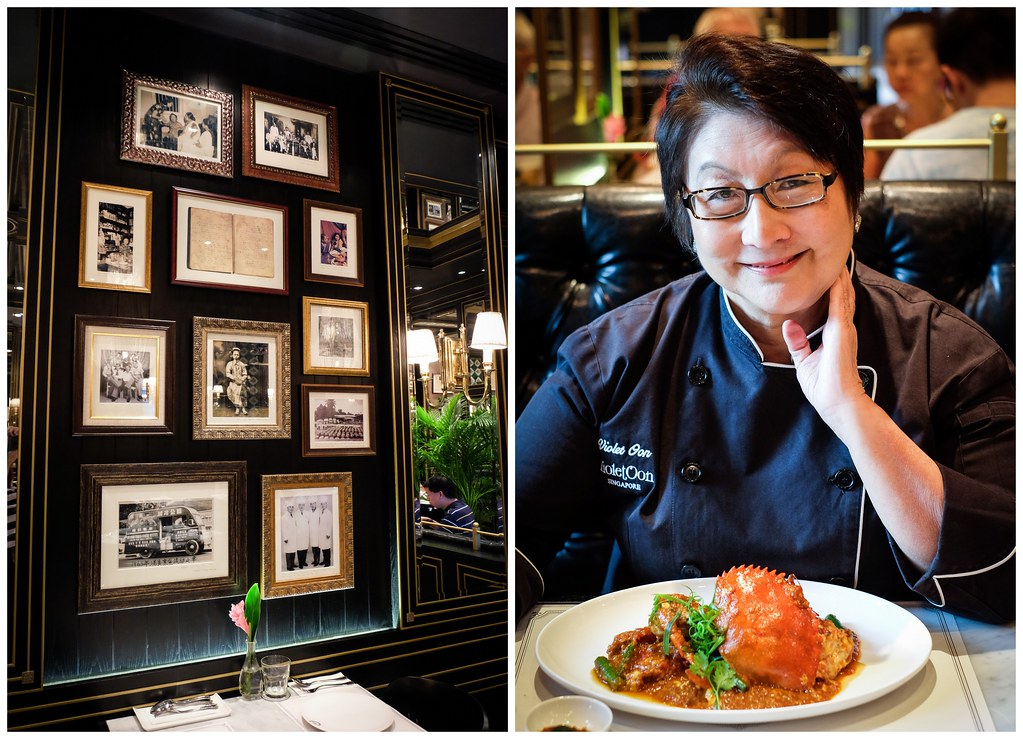
National Gallery, being an iconic building in Singapore, is our pride and joy. And it has finally opened its doors to public. Part of this Singapore floor has been designated for National Kitchen by Violet Oon, the famous food critic, consultant, chef, and cookbook writer in Singapore’s culinary scene. National kitchen? Yes, that’s right. To be able to run national kitchen, that is the real deal. She made her name as a food columnist and later was appointed a food ambassador by the Singapore Tourism Board in the late 1980s. Born a Singapore Nyonya, Violet has experienced the evolution of our local fare since colonial times. We stole some moments with our Singapore culinary chef, and got her to share on her idea of National Kitchen!
Q: Why National Kitchen?
Violet: Personally, this building and its treasure trove of art has special meaning to me in my early professional life as an arts and music critic in the 1970’s. It was in the City Hall that I interviewed and met with the Ministry of Culture officials during my work. I was also involved in securing art collection works of three Singapore masters in Singapore, as well as, an Opera singer at the nearby Victoria Theatre and Victoria Concert Hall. There is a deep sense of history tied to this building and we want to do justice to that through our culinary arts and our curating of the décor at National Kitchen.
Q: How did you resonate the National Kitchen by Violet Oon as a Singapore space?
Violet: As a journalist, it is a lot of effort to put together, especially in cataloging and curating our memory walls. Every picture on these walls a story. National Kitchen is not only about food, we want it to reflect Singaporeans’ life in food. Compared to American’s life in food for example, you should know that food does not play such a big part in their culture and life. However, in Singapore, food is much more important as it is about bonding, family, and hospitality. Let’s say you attend somebody’s home party in Singapore, there must be leftover food for everyone to pack home for it to be deemed a successful home party. This is unlike parties in America where there are individual lamb chops for everyone and everyone finishes it at the party.
Furthermore, the menu at National Kitchen is curated to reflect Singaporeans’ life experiences. For me, my memory of chili crabs in the 1950s was being seated at Bedok beach, with sand under my feet, palm trees swaying and the moon overhead. I remember having chili crab with chunks of white bread. Of course, my satay cravings were satisfied at the Satay Club at Beach Road and again, with sand under my feet. In the 50s/60s, the Chinese requested Indian to cook fish head curry. This is how Singapore families share with each other; Chinese, Indian and Malay housewives will cook for each other and share recipes, which reflects our social interaction. I remember the taste through my memories and this is how the menu of National Kitchen is influenced.

Q: Sometimes, diners complain that the food is too expensive. What’s your take on this?
Violet: Of course, when you heighten the whole look, people expect experience and go for the location. For Singaporeans, there is so much love for the food but resistance for the price. Honestly, a Char Kway Teow fellow puts in more work than a pasta chef. For example, Aglio Olio which consists of simple ingredients of garlic, chili and olive oil can be charged so much higher than a decent plate of Char Kway Teow.
At National Kitchen, we try to cook as authentically as possible. It is a lot of effort put into place to give our food a certain standard and quality. We feel Singapore food deserves to be artisanal as it tastes wonderful. However, not a lot of people think that way. The saddest part is that when you reach the state of being authentic but people do not appreciate because they are already used to the next stage. It is okay as culture has to morph and develop. I am old enough to remember what it was like in the past and I always believe, “you cannot have a future unless you know your past”. You want to write a story, you need many referencing. Therefore, we try to provide a heightened quality and modernize it to be better than the original without causing any major or complete change to its authenticity.
Q: What is the toughest challenge for opening here?
Violet: Staff is an issue but this happens everywhere, not just at National Kitchen. Another challenge was that we want to ensure that everything is handmade and we never order pre-mix. The chefs grind, pound and drain etc. everything themselves.
Just sharing with you, in my first restaurant, we make our own prawn stock. One day, I bought pre-mix prawn stock just to try but my interns strongly resisted with a firm NO. I feel so happy because it’s the young people who are voicing out. How wonderful it is that even they are able to taste the difference. I am very proud of this as it means that the original quality, taste and technique has been imparted into these young people and they know that this cannot be substituted. However, the sad part is for the people who has already substituted the authenticity as they will never be able to differentiate the taste.
Q: What will be the future of the food industry?
Violet: There’s a place that each of us has chosen to be in. There’s a huge space for fast food and food courts. However, the middle level, which includes a lot of young people, is still finding its way. They are trying to be innovative for the sake of being innovative and trying to ascertain the secret to their success. I am very glad that international chefs who came in to set up restaurants in Singapore raised the bar for all of us.

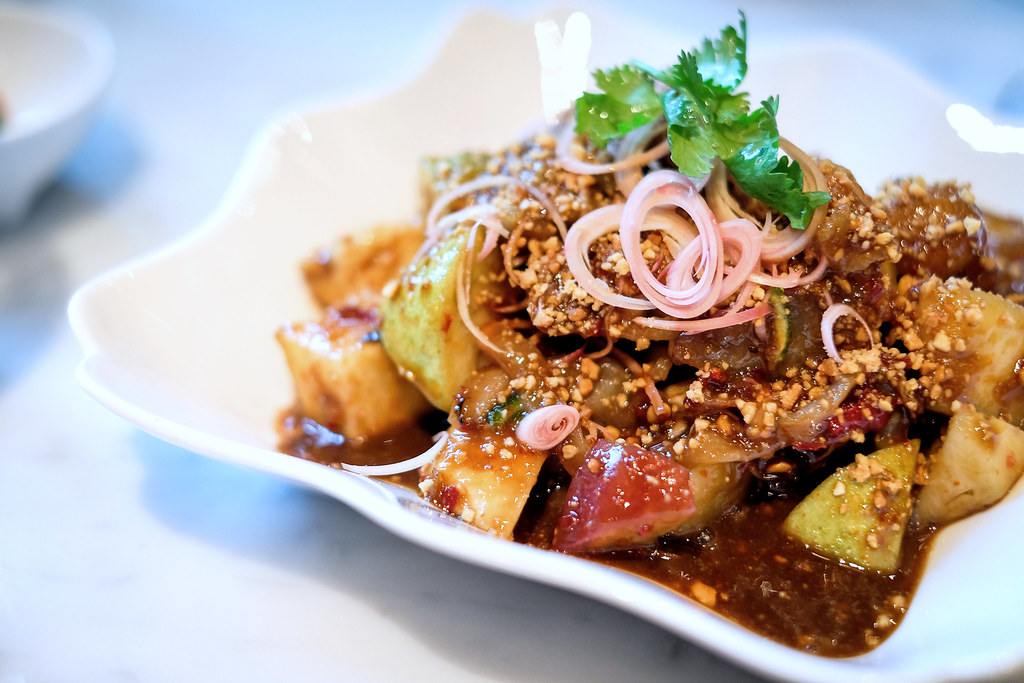
National Kitchen by Violet Oon is a celebration of good, nostalgic Singaporean flavours, perfectly reflecting our colourful culinary heritage. The menu consists of authentic Nyonya cuisine and Singapore dishes from Violet’s growing up years and the recipes she has collected over these years from her mother, home economics teacher and professional chefs etc. The recipes here are authentic and chefs cook without shortcuts or compromises. Every mouth full of each dish is delectable and heartwarming.
Our lunch started with vegetarian Pineapple Patcheree ($4). A South Indian salad made of pineapples, raisins, turmeric, yoghurt and more, this is a refreshing start to our meal. Fruit Rojak ($7) is made with rich hay ko prawn paste but tasted surprisingly light and zesty. With a hint of limau kesturi limes and pink ginger flower, the sauce had pleasing honey-like sweetness and well-rounded flavours. Their version includes rose apple, guava, green mango, jicama (bangkwang), cucumber, and pineapples and jellyfish. There is enough sauce to coat each piece of ingredient evenly.
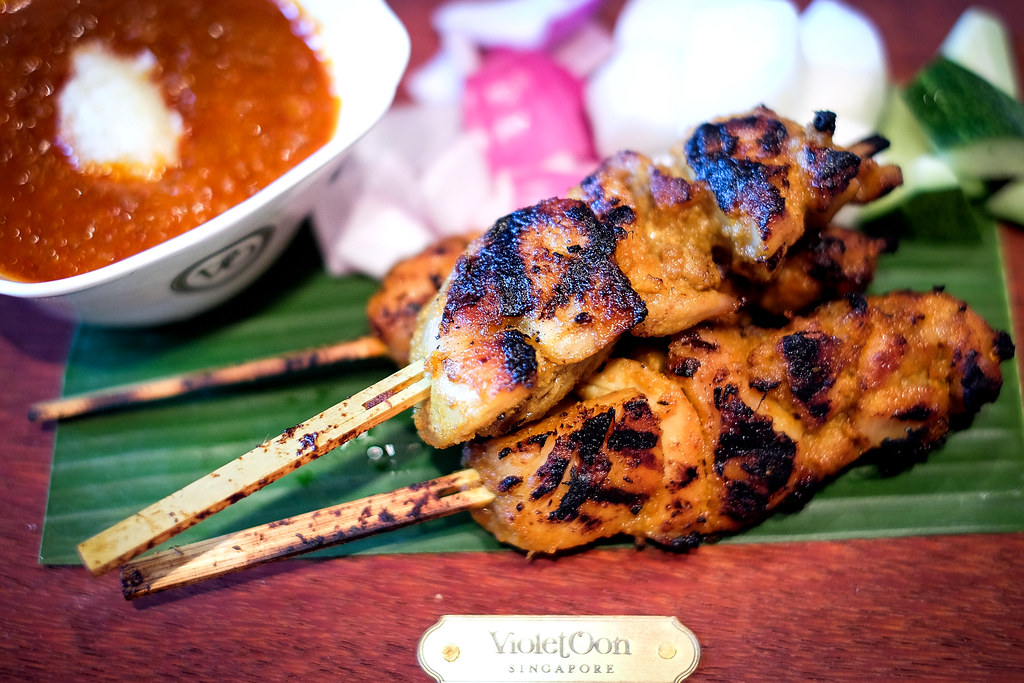
Satay ($12) is a recollections from Satay Club in Beach Road. Thick and chunky pieces of chicken is marinated in spices, served with cucumber, onions and ketupat. The spicy peanut sauce is topped with minced pineapple.
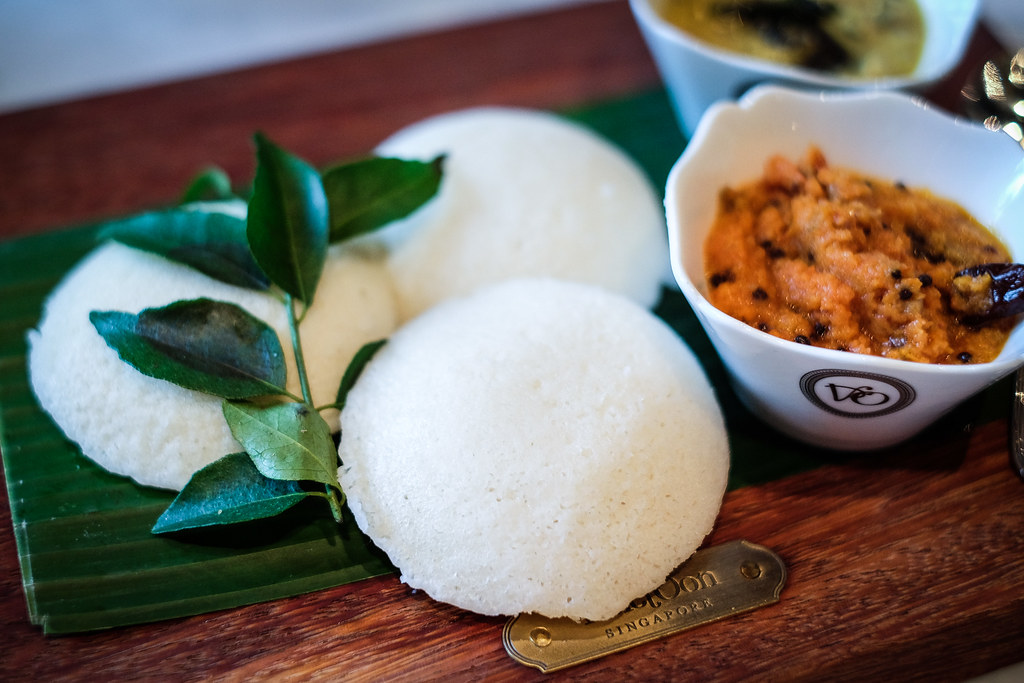
A South Indian family staple, Idly ($7) features parboiled rice and urud dhal lentils soaked, ground till fine and fermented overnight till double in size and steamed. Served with coconut chutney and tomato chutney, it is soft and fluffy. Don’t complain about the price hor. Try making idly at home and you will know how much long hours you have to put in. Plus, the chutneys are all handmade!
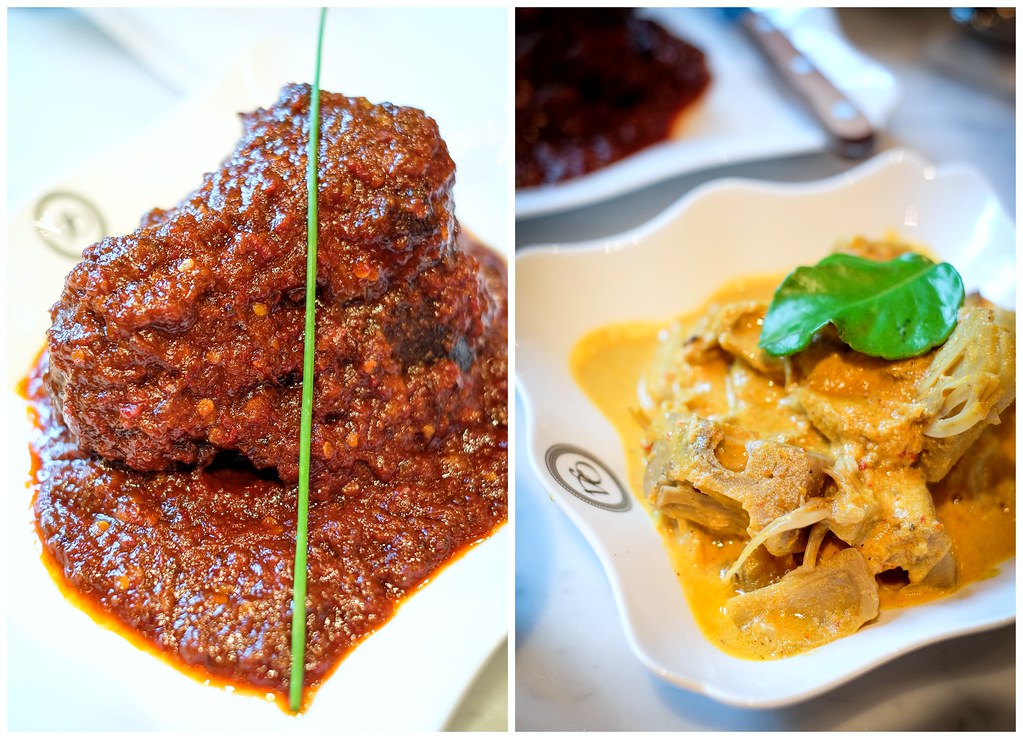
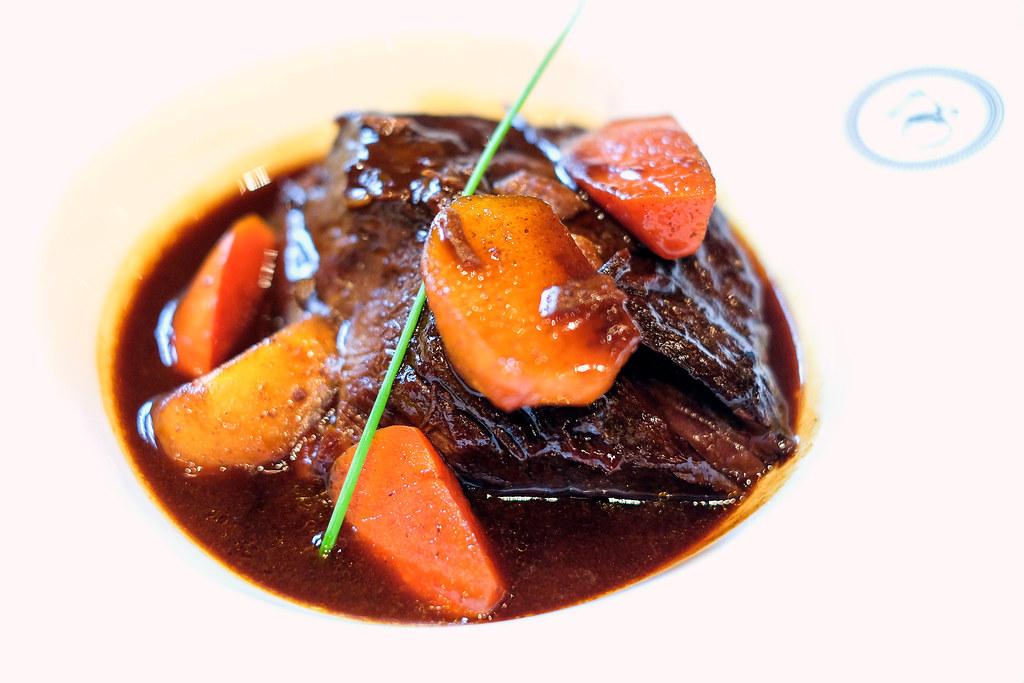
Brisket is the cut of beef that I like best, it is also a cut that needs long hours of braising to get it tender. We tried two beef dishes – Eurasian Beef Brisket Semor ($24) and Daging Chabek Beef Cheek ($35). The former is a beef stew with spices such as cinnamon and cloves. The latter is a recipe from Violet’s indonesian Baba grand aunt. It is lovingly braised in palm sugar and tamarind, infused with coconut cream, chillies, onions and belacan.
Another dish which I seldom see is the Opor Nangka Udang ($14). This is a smooth creamy dish of young jackfruit poached in a spiced gravy with coconut cream and served with Ikan Kurau salted fish bones and kaffir lime leaves.
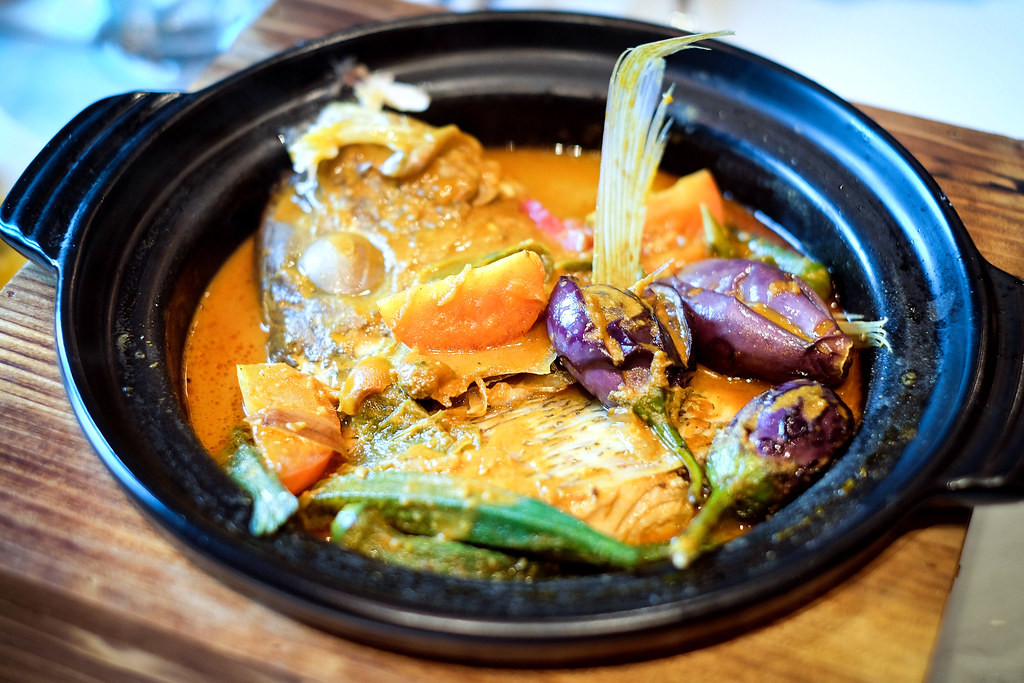
To tourists, they may squirm at the sight of bulging fish eyes surrounded in a sea of red gravy. Yet, for Singaporeans, it is a visually appetising feast. Fish head curry ($35) is unique to Singapore. It mixes the spices of a typical South Indian curry with the fish head, a delicacy among the Chinese.
The ground curry spices are properly fried with no hint of a powdery texture. The robust curry gravy has a dominant coconut flavour with just a hint of tamarind sourness to give it an extra dimension. Curry leaves add that punch and it is served with boiled lady’s fingers and young whole eggplant.
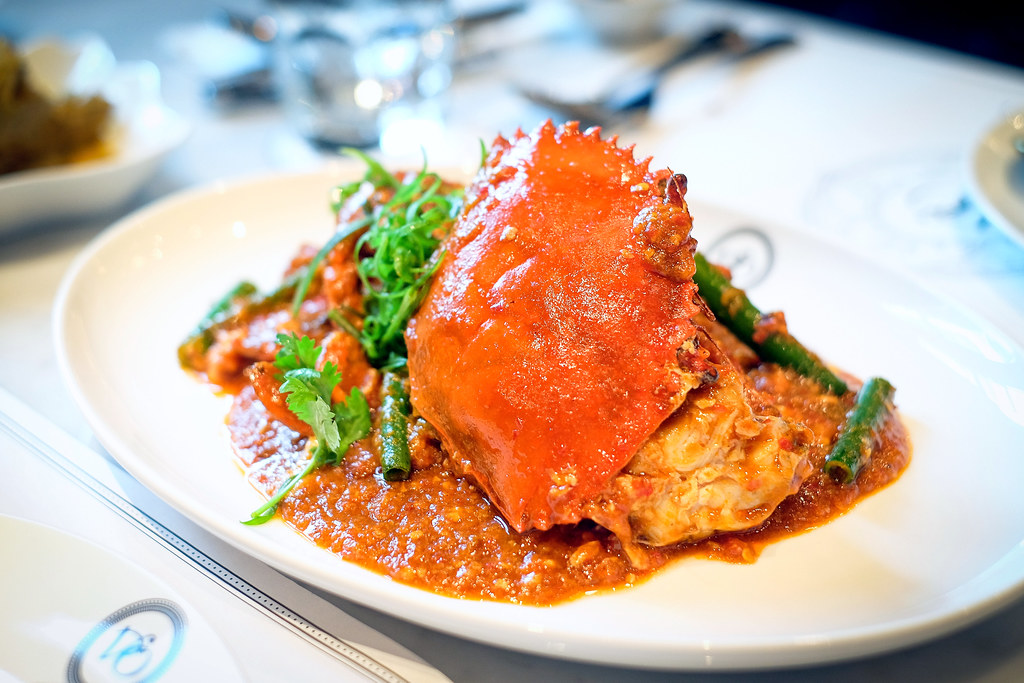
Created in the 1950’s by the original Palm Beach Restaurant, Violet remembers at age 6-7 sitting on the beach with sand under her feet a palm tree swaying above, with the moon and stars in the deep black sky tucking into the CHILLI CRABS and slurping up the thick creamy sauce with chunks of white bread.
Violet’s Chilli Crab (market price) is a re-creation of the taste and texture memories. Bitingly hot chillies and garlic in a piquant multi layered sweet, sour sauce, their version is thicker and has lesser ketchup than many other chilli crab sauce that I have tried. A squeeze of fresh Limau Kesturi just before serving makes this dish complete.
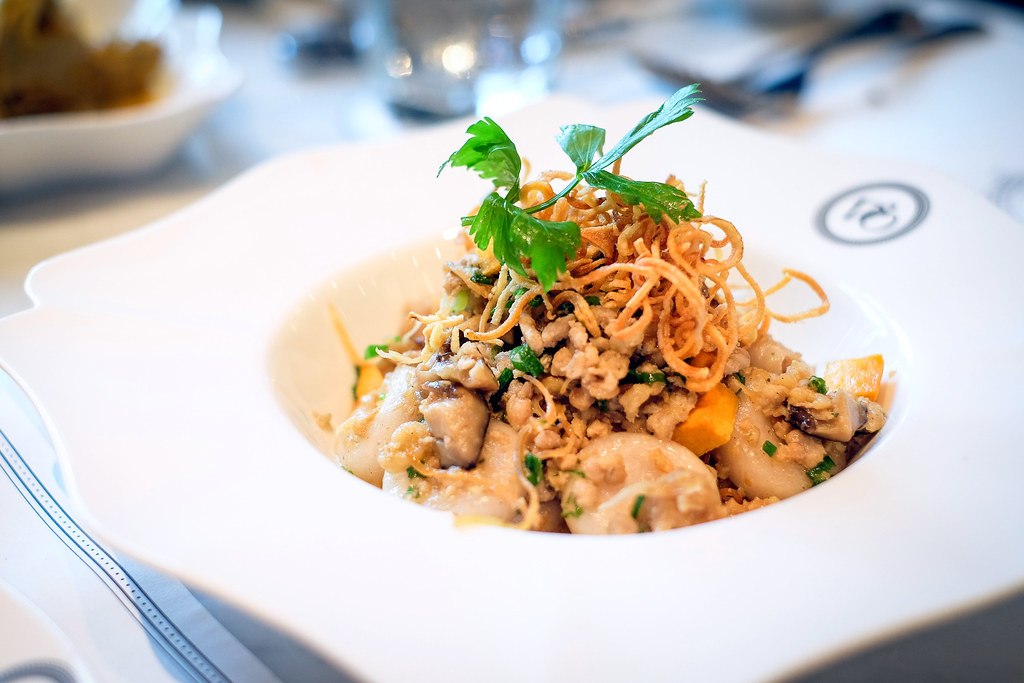
Hakka Abacus Beads ($16) is not common and a good one is even harder to find. My family made it every Chinese New Year, so I know a lot of work goes into making this. Many abacus beads had too much flour so it became too springy.
At National Kitchen, the steamed yam and tapioca flour gnocchi is bigger in size and well kneaded with a soft resilient texture. Tossed with garlic, fish sauce, Chinese mushrooms and yellow bean curd, they are buried under a bed of golden shreds made from dried cuttlefish. The combination of savoury flavor and appealing texture over the abacus seeds is nothing short of sensational.
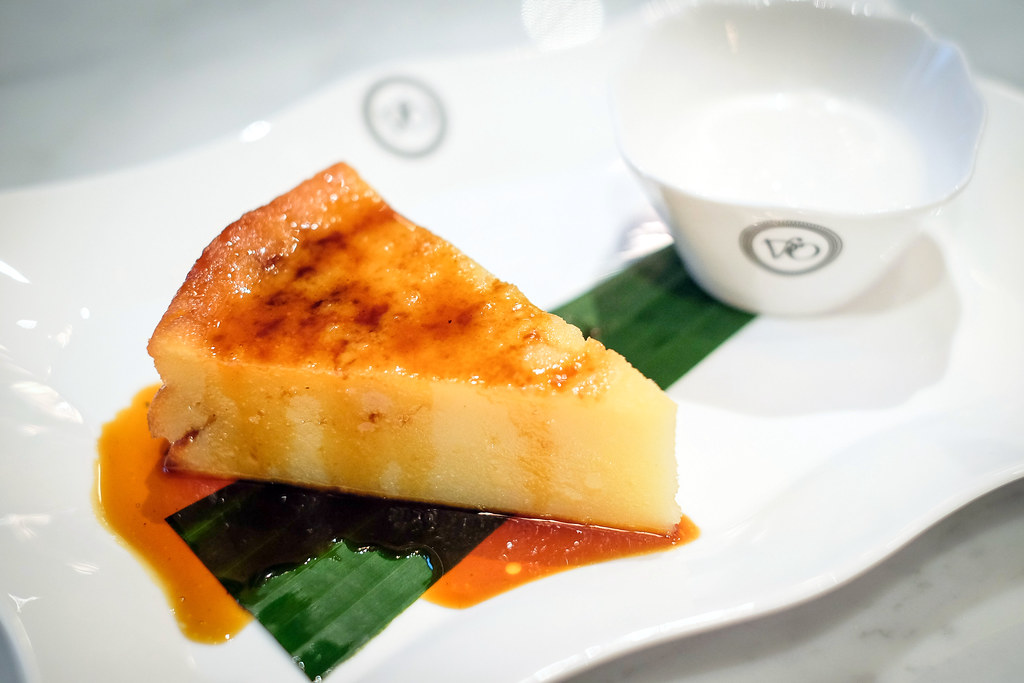
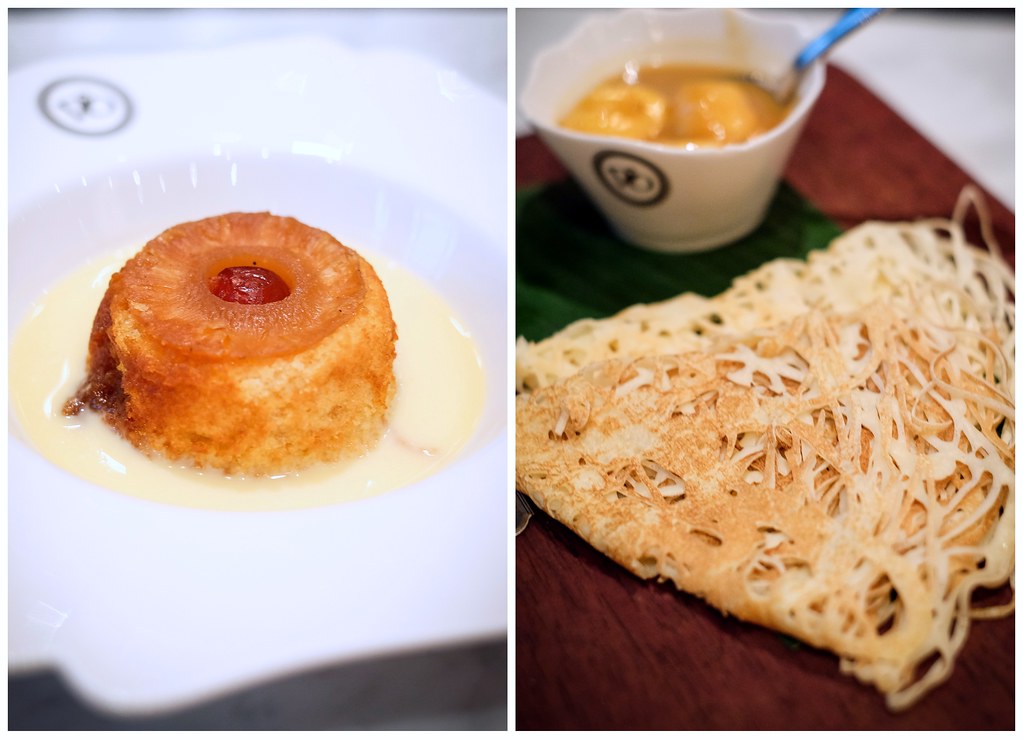

For desserts, we tried include Kueh Beng Kah ($9), Roti Jala ($10), Pulot Hitam with Coconut ($12), and Pineapple Upside Down Cake ($12). The Roti Jala With Gula Melaka And Banana Slices is a sweet Perankan take on the Malay roti jala. I really love their Kueh Beng Kah. An epitome of tapioca cake, it is paired with gula Melaka and coconut cream.
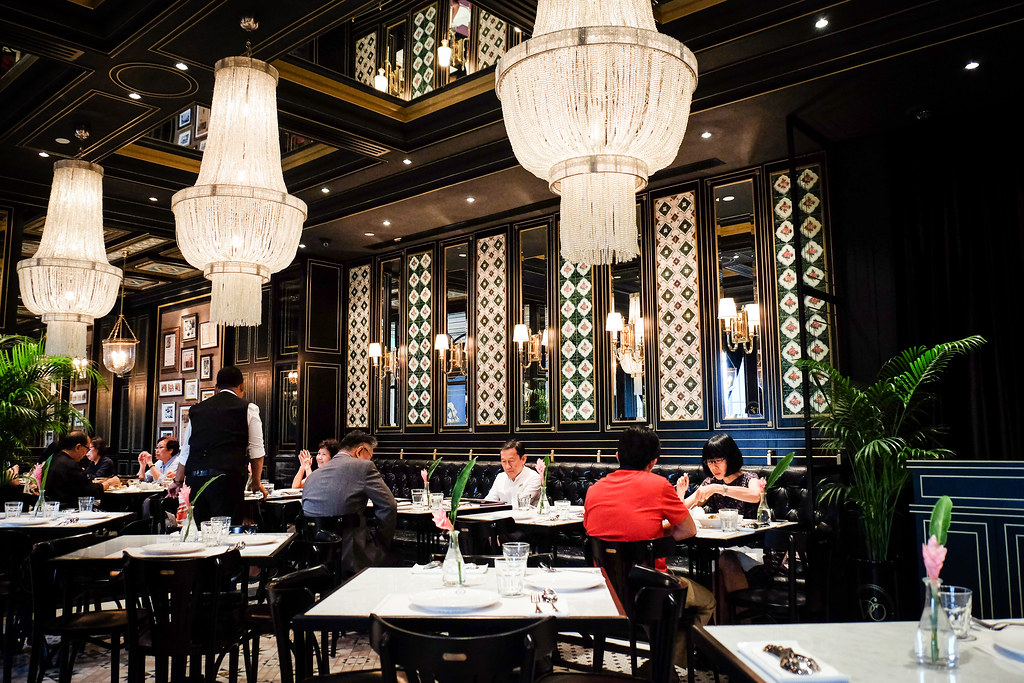
Violet has also worked with a traditional Singapore coffee bean roaster to create her own kopi blend. Robusta and Arabica coffee beans are combined, roasted with margarine and caramelised, then prepared the old-fashioned way with long-nosed metal jugs and sock. Or try their homebrewed ginger beer and kesturi limes.
National Kitchen by Violet Oon definitely has something for everyone. As you dine in the iconic National Gallery, it allows you to re-live many treasured memories. I may not be old enough to remember the dishes, but the chilli crabs and abacus beads did bring back some wonderful memories. As for Violet, she is definitely an amazing character. She knows what she is doing and she always has a smile on her face. That makes the whole experience very homely.
National Kitchen by Violet OON
Address: 1 St. Andrew’s Road, #02-01 National Gallery Singapore, City Hall Wing, Singapore 178957
Opening hours: 11am – 2.30pm (lunch) and 6pm – 9.30pm (dinner) daily
Website: www.violetoon.com
Let’s build a food community that helps to update the food news in Singapore! Simply comment below if there’s any changes or additional info to National Kitchen by Violet OON. We will verify and update from our side. Thanks in advance!



